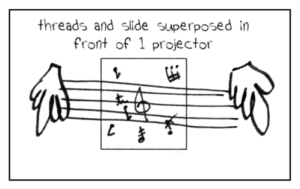for 13 prepared electric fans
In my orchestration book, electric fans are classified in diverse instrumental families considering diverse features: they undoubtedly belong to the wind family; they are on top of that, noise generators; from a kinetic perspective they are members of the instruments “that spins around.” Multiple interpretations of the same allow a special interconnection between objects, spreading the chamber music experience into a unique personal listening.
“A choir of small ventilators, that like a mechanical garden, move their heads bringing sound and movement to the music.”
The more concrete, the more abstract
Rather than prescribing an ideal music of the future, Schaeffer’s didacticism
requires us to submit to a process in which sound is re-imagined or experienced anew, and new effects of listening are discovered and learned.
Ian Stevenson, Schaeffer’s sound effects
The fan is attached to the sounds as much of the sound is attached to the fan. We cannot conceive the machine without the sound, or the sound without the machine: one refers to the other. But when the fan is on stage making music, the sound appears to lose its inherent connection to its source and becomes an independent phenomenon: we start hearing the fan as a music instrument. After this switch in our mind, we can focus on the sound itself: its overtones, pitch, colored noise, residual tones, and all kinds of glorious “side- effects”. Curious enough, the production of fresh air, the main purpose in any electric fan, becomes something completely irrelevant. When the fan goes musical, the sound can be undoubtedly routed with its source without losing its identity: it looks like a fan, it sounds like a fan, it is a fan!. Even the modifications applied to the sound by the use of “extended techniques” enhancing and preserve the nature of the sound as two sides of the same process.
“everyday listening, which identifies sound sources as objects or events; and musical listening, which focuses on the intrinsic properties or features of sounds.”
William Gaver, How do we hear in the world?
When a fan is performing in a concert hall, this new context brings new associations and displacements in our minds. We can concentrate more easily on the sounds because the device is on stage. Same as we focus on the textures, colors, size, and position of Duchamp’s porcelain urinal because it is shown in an art gallery. Context is substantial.
Matter matters
What is music? What is a sound object? This unanswered question triggers all kinds of different theories and works, inspiring not only the composition of new music but mainly changing our way of listening.
• Video (excerpts)
• Photo gallery
